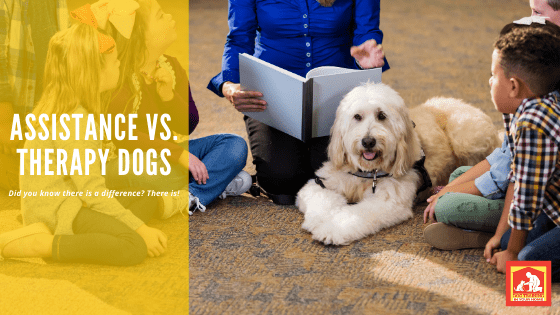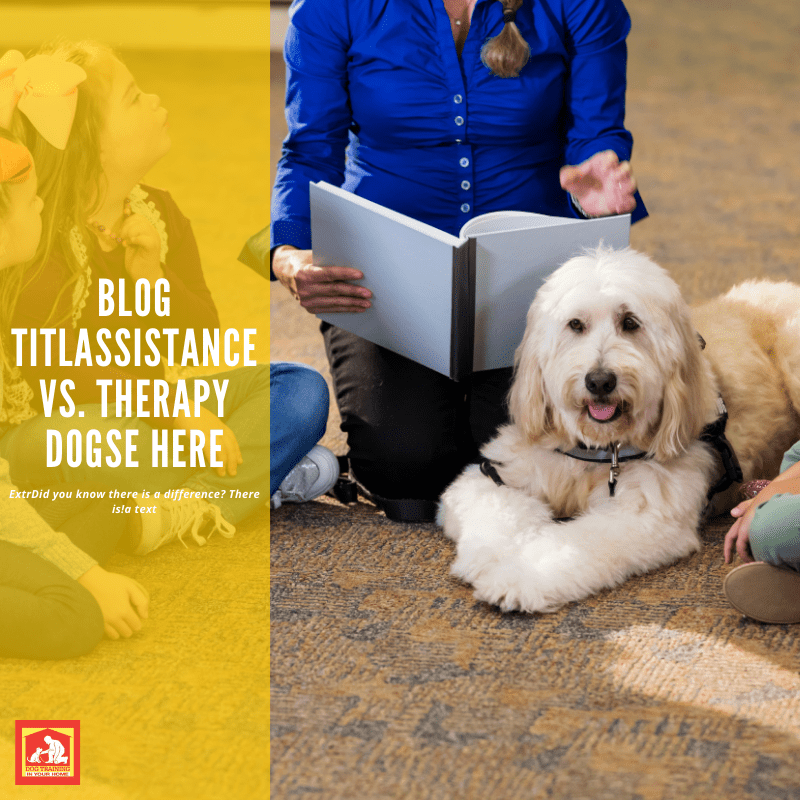
These Aren’t Your Regular Family Dogs
There is no doubt dogs help humans. Whether it’s emotionally, physically, or even spiritually. Research has proven they improve our mood, among other good things. But some dogs go above and beyond what our regular house dogs can do. Assistance Dogs (AKA Service Dogs) and Therapy Dogs are examples of these.
Over the last few years, there have been some improvements in the recognition of the need for service animals and therapy animals. You may not encounter these animals on a regular basis, but chances are you will probably see one at some point in your life. Having a basic knowledge of the differences can help you avoid some potentially awkward situations. If you have a therapy or service animal, you also want to be aware of their legal rights. They don’t all have the same rights, as you will see.
Classifications of Therapy Dogs and Service Dogs
We’re going to break this post down into 4 types of dogs. They all play different roles for their owners, handlers, and people they interact with. The 4 types are:
- Therapy Dogs
- Emotional Support Animals
- Assistance Dogs
- Working Dogs
There is one of the main distinctions between therapy dogs and the other three listed above. Therapy dogs provide a service for other people; ESAs, assistance dogs, and working dogs provide a service/task/job for the owner/handler.
Therapy Dogs
As mentioned above, therapy dogs help people other than their owner or handler. They are comfort dogs – they make the people they are visiting feel better in their environment. Most often the dog’s owner is their handler. They can live with another owner, however, because they are not necessarily trained to live with a specific person. The handler and dog make up a “team”. They may interact with lots of different people. So a calm temperament and loving disposition are great traits for therapy dogs.
The Americans with Disabilities Act (ADA) does not consider therapy dogs to be service animals. As such they don’t have the same legal rights as service animals do. Common settings you will see therapy dogs include hospitals, libraries, schools, nursing homes, and other clinical settings. They provide comfort, love, and affection to the people there. Most of the time each facility has its own rules and regulations for a therapy dog coming in. Therefore individuals who want to volunteer their dog as a therapy dog need to contact those facilities to check.
As of the writing of this article, there are no uniform state or national rules that regulate and certify therapy dogs. As a general rule, the non-profit or individual that is offering their services should train, insure, and license their therapy dog.
Emotional Support Animals (ESAs)
These dogs are sort-of “in-between” a therapy dog and service dog (IMO). While they may be trained for a specific owner, they are not necessarily trained for a specific task or duty to aid their owner. Therefore, the ADA still does not consider ESA dogs as service animals.
To be an official ESA, there must be a prescription from a mental health professional for a patient with a mental diagnosis. These companion animals are commonly used to ease:
- Anxiety
- Depression
- Some phobias
- Loneliness
- Panic attacks
ESAs still have limited legal rights, but they have more rights than therapy dogs. The Fair Housing Act mandates “reasonable accommodations” for ESAs, even in buildings that don’t allow pets. Airlines do allow ESAs on flights, as long as the owner has a letter from their doctor or therapist. Regulations for ESAs can vary between airlines, so be sure to check them before booking a flight.
Assistance Dogs (AKA Service Dogs)
These dogs perform a specific service, task, or job for their owner to improve their independence and quality of life.
You can find the direct definition from the Americans With Disabilities Act Title III.
While some people use the term assistance dog and service dog interchangeably, Assistance Dogs International has 3 classifications of assistance dogs.
Related: How To Interact (or not) With an Assistance Dog
Classifications of Assistance Dogs
- Guide Dogs – used for helping those who are blind or have vision impairments.
- Hearing Dogs – used for those who are deaf or have hearing impairments.
- Service Dogs – used for individuals who have a disability other than hearing or vision..
There are many people service dogs can help. Here are a few examples:
- Physical disabilities – these dogs can aid individuals with physical limitations or in a wheelchair.
- Psychiatric disabilities – these dogs can lesson the effect of an episode (such as PTSD).
- Autism – these dogs can help distinguish important sensory signals, alert their owner to repetitive behavior or overstimulation.
- Seizures – these dogs can stand guard over their owner during an episode or go get help.
These dogs have the most legal rights of any mentioned so far. The ADA mandates full public access rights: they are permitted in all housing accommodations, and allowed on airplanes and other public transportation. Even if a business doesn’t normally permit animals, they must allow service dogs. The owner/handler legally can be asked only 2 questions:
- Is this a service animal?
- What task does it perform for you?
Please remember – these highly trained dogs are doing a job for their owner when they are out in public. Be respectful, and ask the owner if it is OK for you to approach their dog if it is not apparent from their vest or harness. Most vests or harnesses have a “do not touch” patch on them that will remind you 😉 If you are walking your dog and are going near a service animal, please keep your dog in control. It’s only fair for everyone 🙂
Related: 5 Interesting Facts About Seeing Eye Dogs
Working Dogs
You may be more familiar with these because you’ve probably seen them more in public. Working dogs are trained for a purpose. They learn and perform specific jobs or roles to assist their human companions in certain locations. As with therapy dogs, the handler may not be the dog’s owner, but in most cases they are.
Examples of working dogs include:
- Search and Rescue Dogs
- Explosives Detection
- Drug Detection
- Cancer Detection
- Allergy Alert Dogs (think peanuts, gluten, etc.)
- Bed Bug Detection (I’ve heard of termite detection, too)
- K-9s on local police forces
These dogs are not often subject to legal ramifications because they are trained specifically to perform their jobs in certain locations (hotels, airports, schools, etc.).
Hopefully, this helped to clear up any confusion you may have had determining any differences between these awesome canines. It’s amazing what dogs can do! As they constantly show us what they are capable of, we continue to be amazed!
We can help train a therapy or service animal (although we do not offer the certification). CALL TODAY if you’re interested!
Call today: 843-360-6033 FIRST VISIT FREE!
Any age, Any breed; Veterinarian Recommended







